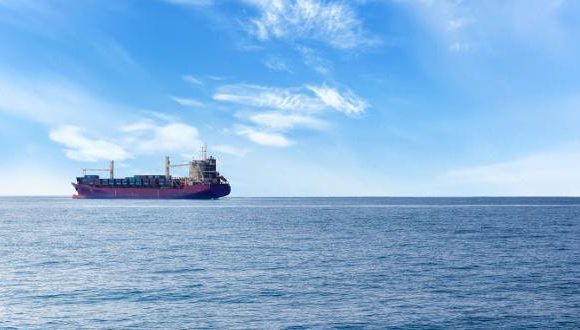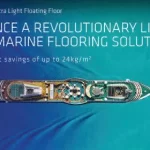Charting a Green Course: How Seaports are Transitioning to Renewable Energy
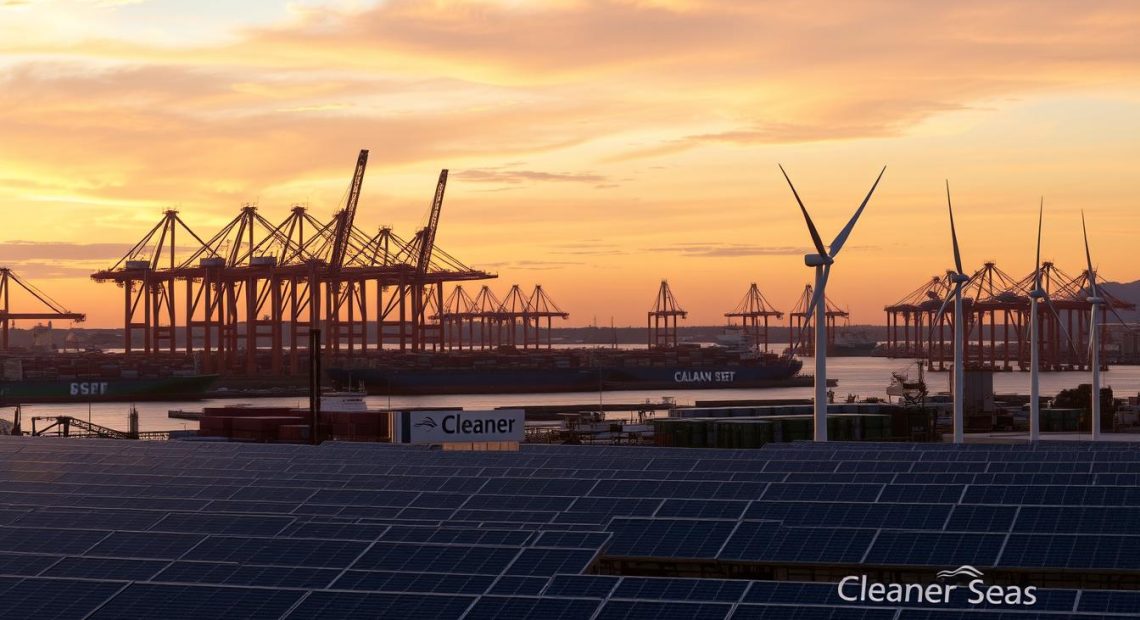
The maritime industry is key to global trade, moving 90% of the world’s goods. But it has a big problem: it’s a big polluter. Shipping is responsible for about 3% of global emissions, more than airlines.
UK seaports are leading a big change to renewable energy. This change will cut emissions, improve energy security, and boost the maritime sector’s economy.
Using green technology in seaports is a big step to reduce the industry’s harm to the environment. If we don’t act, shipping emissions could go up by 50% to 250% by 2050. But, by using low-carbon tech, we could cut emissions by 80% by 2040.
The UK is at the forefront of this green shift. Seaports are looking at different renewable energy options. Solar and wind power are changing maritime operations, leading to a cleaner, more efficient future in global trade.
Key Takeaways
- Maritime industry transports 90% of global goods but contributes 3% of greenhouse gas emissions
- UK seaports are leading the transition to renewable energy sources
- Without action, shipping emissions could increase by up to 250% by 2050
- Adopting low-carbon technologies could reduce emissions by 80% by 2040
- Renewable energy in seaports offers environmental, economic, and energy security benefits
- Solar power and wind energy are key sustainable alternatives being explored
The Importance of Renewable Energy for Seaports
Seaports are key in global trade, but they use a lot of energy and harm the environment. Moving to clean energy is vital for these important maritime centers.
Environmental Impact
Old energy sources in ports cause a lot of carbon emissions. Ships are responsible for about 3% of global CO2 emissions, that’s 1 billion tonnes a year. Switching to renewable energy can greatly cut down on this.
Economic Benefits
Going green can save money too. A solar project in Mauritius shows this. It cost USD 1 million but will cut electricity bills by 65% and emissions by 680 tonnes a year.
Energy Security
Renewable energy makes ports more secure. By 2050, ports could use ten times more electricity, with 70% coming from renewables. This makes ports less reliant on unstable fossil fuel prices and keeps the power steady.
- Renewable energy could account for 70% of port electricity generation by 2050
- Energy efficiency measures could halve growth in energy use and CO2 emissions
- Ports’ carbon intensity for energy use is projected to halve by 2050
Switching to renewable energy is not just good for the planet. It’s also smart for the economy and energy security. As trade grows, using clean energy in ports is key for a sustainable future.
Current Trends in Renewable Energy Adoption
The energy transition is speeding up in UK seaports. They are moving towards zero-emissions energy solutions. This change is making port operations more sustainable and setting new standards for the maritime industry.
Growing Use of Solar Power
Solar power is becoming more popular in UK ports. In 2023, solar capacity jumped by 88% to 18.6 gigawatts. It now ranks as the fourth-largest source of installed capacity.
Ports are putting photovoltaic panels on warehouses, terminals, and unused land. This helps generate clean electricity and cuts down on grid power use.
Wind Energy Innovations
Wind energy is key to making seaports more sustainable. Even though there was a 14% drop in capacity additions to 2.6 GW in 2024, wind power beat coal for two months straight. Ports are looking into both onshore and offshore wind farms to power their operations.
Renewable energy in seaports has its challenges, but the advantages are clear. With 30.3% of electricity from renewables in 2023 and a 120% rise in battery capacity, ports are ready to lead the way to a zero-emissions future in the maritime sector.
Key Technologies Driving Transition
Seaports are turning to renewable energy and clean solutions to cut down on carbon emissions. The energy sector is responsible for 75% of global greenhouse gas emissions. So, green technology is key to meeting sustainability targets.
Solar Photovoltaics
Solar power is a top choice for renewable energy in ports. Big solar panels on buildings make clean electricity. This method is getting cheaper, making it the best choice for new power in many places.
Offshore Wind Turbines
Coastal areas are perfect for wind energy. Wind farms near ports can produce a lot of power. They aim for 90% of global electricity to come from renewables by 2050. These turbines use sea breezes for a steady supply of green energy.
Energy Storage Solutions
Storing energy from renewables is a big challenge. Batteries and pumped hydropower are the main solutions. By 2019, pumped hydropower made up 91% of the world’s energy storage. New battery systems, like liquid metal batteries, keep 99% of their charge after 5,000 cycles. They’re changing how ports manage energy.
These technologies help ports aim for zero emissions, meeting global climate goals. As the maritime sector goes green, seaports are leading in clean energy. They’re setting the stage for a greener future in shipping and logistics.
Case Study: The Port of Southampton
The Port of Southampton is leading the way in using sustainable power. It’s on a mission to cut down on harmful emissions. The port is using green alternatives to make a positive change.
Renewable Energy Initiatives
Southampton Port is working hard to reduce pollution. It’s cut down on road traffic, which helps the air quality. This move has removed 300,000 trucks from UK roads each year.
It’s saved about 4,500 tonnes of CO2. That’s like taking 13,500 lorries off the road.
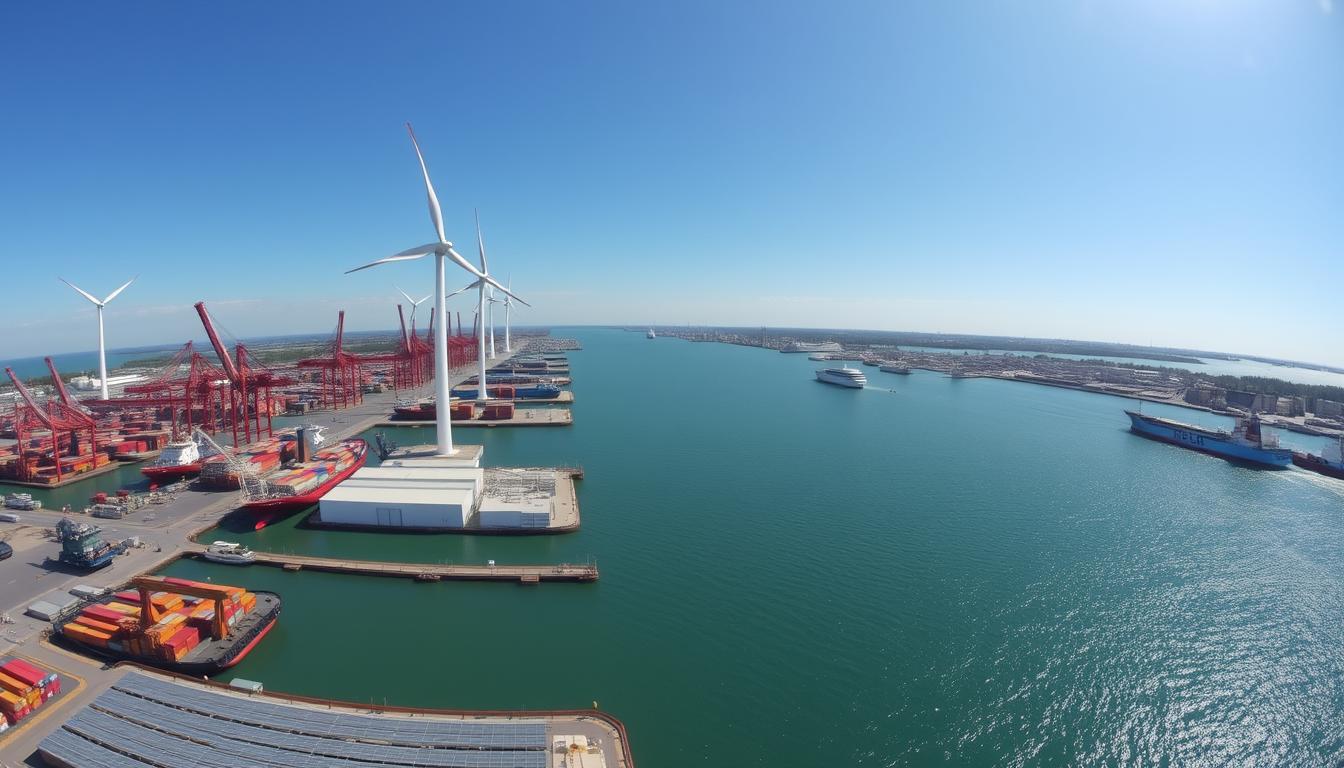
The port has also updated its equipment. It now uses hybrid electric straddle carriers. This has cut NOx emissions by 54% compared to old models.
The port aims to cut its carbon footprint by 42% by 2030. It wants to be carbon neutral by 2050.
Impact on Local Economy
Switching to green energy has brought new jobs. Williams Shipping now helps with renewable energy for wind farms. This has created jobs for drivers who speak multiple languages.
The port is also teaching kids about the environment. It works with over 200 children every year. They learn about trade, logistics, and green practices in the sea industry.
This helps the local economy and teaches kids about caring for the planet.
“Our transition to sustainable energy sources is not just about reducing emissions. It’s about creating a greener future for our community and opening up new economic opportunities in the renewable energy sector.”
The Port of Rotterdam: A Benchmark in Sustainability
The Port of Rotterdam is a top example of green growth in the sea trade. It’s Europe’s biggest port, handling 469.7 million tons of cargo every year. This makes its push for clean energy even more notable.
Implementation of Green Technologies
Rotterdam’s port authority has welcomed renewable energy with open arms. They’ve put in big shore power systems. This lets ships use local electricity instead of diesel generators.
The port has also started projects to turn waste into power. These efforts, along with smart energy systems, make Rotterdam a leader in green ports.
Results and Future Plans
The green tech has made a big difference. The port wants to cut greenhouse gas emissions by 95% by 2050. They’re making good progress, with a 20% drop in CO2 emissions from port activities.
Rotterdam is aiming to become a hydrogen hub. This is key for a greener economy. They’re working with big energy companies like Total and Engie on green projects.
Their goal is to switch from fossil fuels to biomass, recycled materials, and green hydrogen. This will set a new standard for the sea trade.
Challenges Facing Seaports in Transition
Seaports are key in the energy transition and decarbonisation. They are moving to sustainable power sources but face big challenges. The shift from traditional fuels to new ones brings both obstacles and chances for innovation.
Infrastructure Limitations
One big problem is the need for new infrastructure. Ports must update their facilities for new energy tech. For example, the Port of Dover might need 20 times more electrical power by 2035.
This increase is mainly because of battery-electric vessels on the England-France route.
Regulatory Hurdles
Regulations often don’t keep up with new tech. Current rules can slow down the use of renewable energy in ports. The International Maritime Organisation wants to cut shipping emissions by 20-30% by 2030, and 70-80% by 2040.
These goals mean big changes in how ports use energy.
Despite these hurdles, there are chances for growth. Ports are becoming energy hubs, reducing their need for the grid. Creating regional port clusters can also help manufacturers in the long run. As the maritime sector changes, tackling these challenges will help make it more sustainable.
Policy and Regulatory Framework in the UK
The UK government has big plans for renewable energy and sustainable development. By 2020, they wanted 15% of energy to come from renewables. Now, they aim to cut greenhouse gas emissions by 78% by 2035.
Government Support for Renewable Energy
The UK is serious about zero-emissions energy. They’ve set a goal to increase offshore wind to 50GW by 2030. They also plan to invest £1 billion in new energy tech, including 5GW of hydrogen production by 2030.
Local Initiatives and Incentives
Local efforts are key in the shift to renewable energy. In 2023, 51% of the UK’s electricity came from zero-carbon sources. Wind farms made up 29.4%, while bioenergy and solar added 5% and 4.9% respectively.
- The Energy Act 2023 established the National Energy System Operator (NESO)
- Ofgem’s duties now include considering consumers’ interests in meeting net zero targets
- The government expects £100 billion in private sector investment in the energy sector by 2030
These plans could create up to 480,000 jobs in energy by 2030. This shows the economic gains of moving to renewable energy in the UK’s maritime sector.
Collaborations with Private Sector
Seaports are moving towards renewable energy with help from private companies. These partnerships bring new ideas, skills, and money to support green projects.
Public-Private Partnerships
Public-private partnerships are key in making UK ports greener. They mix government backing with private sector know-how to start renewable projects. For example, the Port of Southampton teamed up with an energy company to add solar panels. This move cut down on carbon emissions and saved on energy costs.
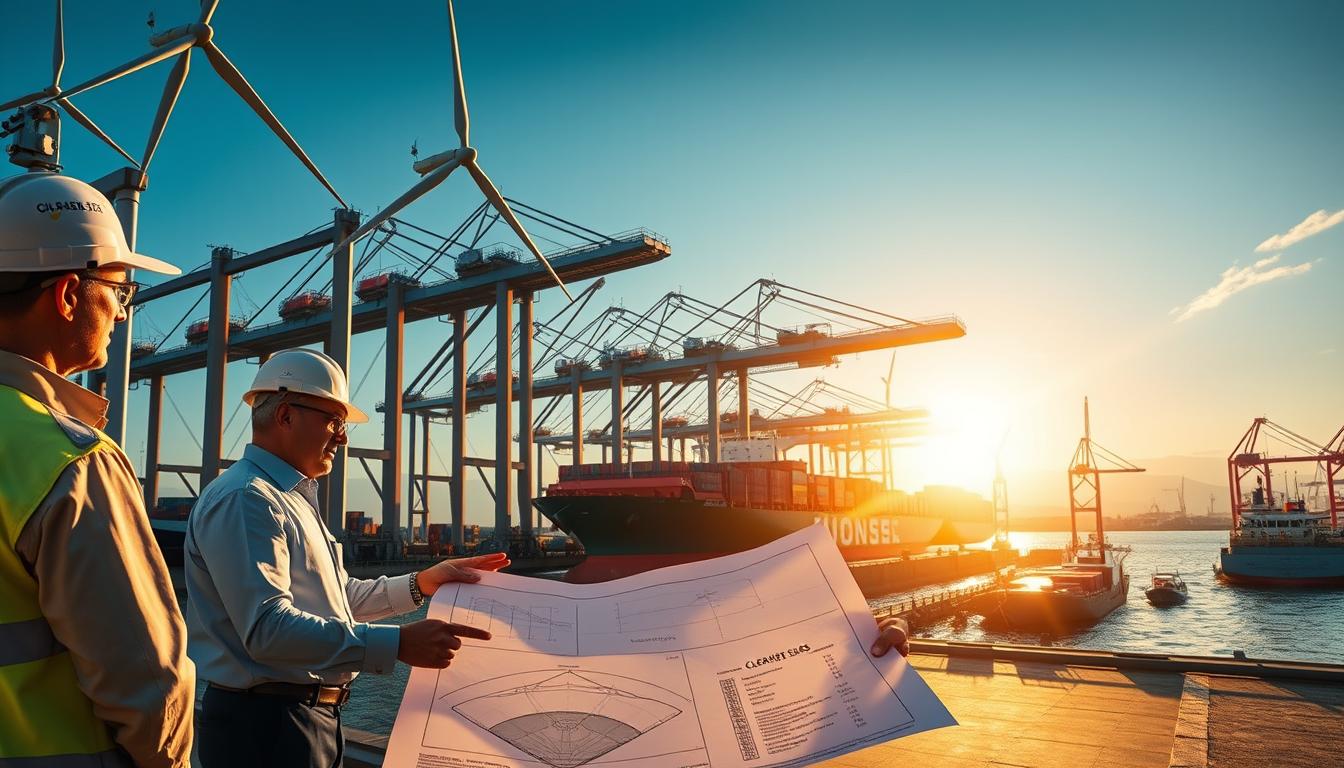
Innovative Funding Models
New ways to fund green projects in ports are being explored. Green bonds, crowdfunding, and energy performance contracts are among them. The Port of Liverpool used a green bond to fund a big wind farm. This shows how these new funding models can work.
Digital tools and automation are making these partnerships better. Advanced analytics and AI help use energy more efficiently. Blockchain technology makes renewable energy deals clearer. These tools help ports use less fuel and waste, helping them meet their green goals.
- Green bonds finance large-scale renewable projects
- Crowdfunding enables community involvement in port sustainability
- Energy performance contracts tie funding to efficiency gains
As seaports move towards renewable energy, working with the private sector is essential. These partnerships bring new ideas, funding, and speed up the transition to a greener maritime industry.
The Role of Local Communities in Driving Change
Local communities are key to making seaports more sustainable. They help use eco-friendly options and support renewable resources. The UK government has given £19 million to help local areas grow green.
Stakeholder Engagement
Working together is essential for renewable energy projects. The Community Energy Contact Group helps groups talk to the government. This has led to 495 community energy projects in England, all about going green.
Community Benefits
Renewable resources help local communities a lot. The Community Energy Fund helps groups start projects like solar panels and wind farms. These projects are for the community, with any profits going back to them.
- 72% of community businesses report a positive impact on the environment and climate change
- 53% of community businesses serve as hubs for their communities
- Community energy projects often operate in areas facing multiple disadvantages
By getting local people involved, seaports can make a big difference. They can make their areas more energy secure and green.
Future Prospects for Renewable Energy in Seaports
The future of seaports is closely linked with renewable energy and reducing carbon emissions. The UK wants to reach net zero emissions by 2050. Ports are leading the way in this energy shift.
The maritime sector is looking for new ways to cut down on carbon. It’s embracing sustainable practices to meet these goals.
Emerging Trends
Seaports are quickly adopting renewable energy. The Port of Aberdeen’s ‘Shore Power in Operation’ project aims to reduce vessel emissions by over 80% at berth. This project could save 62,000 tonnes of CO2 over 20 years.
Electric vessels are becoming more common. The Artemis EF-24 Crew Transfer Vessel is a 100% electric ship. It shows a big step forward in reducing emissions. Companies like North Star and Stilstrom are working on making Service Operation Vessels electric.
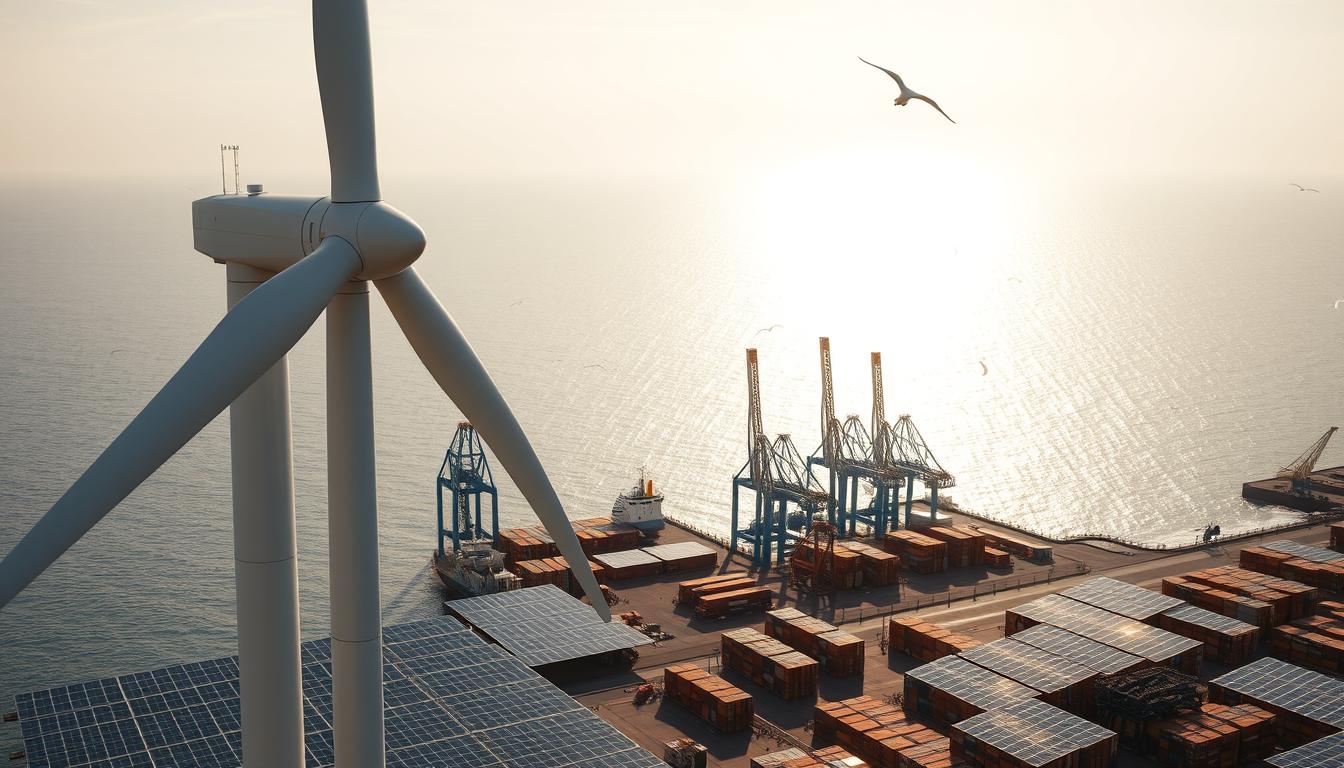
Long-term Sustainability Goals
UK ports are setting big targets for carbon neutrality. Using more shore power could cut emissions by 78% at berth. This would mean a yearly reduction of 34,000 tonnes of CO2.
The Port of Liverpool is installing 63,000 solar panels. They will generate 31MW of renewable electricity. This will meet 25% of the port’s electricity needs every year.
Hydrogen is becoming key in the energy transition. The European Union plans to make 15 million tons of renewable hydrogen. This move towards cleaner energy will cut emissions and create jobs in the maritime sector.
Conclusion: The Path Forward for Green Seaports
The move to renewable energy in UK seaports is a big step towards a greener future. Clean energy is set to power 95% of Great Britain’s electricity by 2030. Seaports will be key players in this shift, helping the environment and boosting the economy.
The UK aims to cut greenhouse gas emissions to zero by 2050. Seaports are leading the way, planning to use 43-50 GW of offshore wind by 2030. This move could create up to 60,000 jobs in offshore wind, showing the economic gains of going green.
Despite hurdles, the future for green seaports looks bright. £40 billion will be spent on clean energy from 2025 to 2030. Seaports can lead in making the maritime sector more sustainable and strong. With innovation, teamwork, and community support, seaports can power their operations with renewable energy, setting a new standard for maritime trade.
FAQ
Why is renewable energy important for seaports?
What are the main renewable energy sources being adopted by UK seaports?
How is the Port of Southampton leading in renewable energy adoption?
What challenges do seaports face in transitioning to renewable energy?
How is the UK government supporting the adoption of renewable energy in seaports?
What role do public-private partnerships play in renewable energy adoption at seaports?
How are local communities involved in seaports’ transition to renewable energy?
What are some emerging trends in renewable energy for seaports?
How does the Port of Rotterdam serve as a benchmark for sustainability?
What are the long-term sustainability goals for UK seaports?
Source Links
- https://www.nautilusshipping.com/the-green-energy-transition-in-maritime-trade-a-path-to-net-zero-by-2050 – Navigating the Maritime Energy Green Transition: Read Here
- https://www.trafigura.com/media/pt3jmlsd/2023_trafigura_charting_a_course_en.pdf – PDF
- https://www.dnv.com/news/ports-can-be-the-front-runners-of-the-energy-transition-if-port-authorities-and-industry-sectors-join-forces-179736/ – Ports can be the front runners of the energy transition, if port authorities and industry sectors join forces
- https://www.hafen-hamburg.de/en/port-of-hamburg-magazine/energy-hub/energy-transition-offers-great-opportunities-for-port-of-hamburg/ – portofhamburg.com | Energy transition offers great opportunities for Port of Hamburg
- https://unctad.org/system/files/non-official-document/4_Kailash-Mauritius_7Dec2023-EnergyTransition&ports-in-Africa-UNCTADWebinar-FINAL-_pdf_version.pdf – Energy transition & ports in Africa
- https://www.ren21.net/what-are-the-current-trends-in-renewable-energy/ – What are the current trends in renewable energy? – REN21
- https://www2.deloitte.com/us/en/insights/industry/renewable-energy/renewable-energy-industry-outlook.html – 2025 Renewable Energy Industry Outlook
- https://climatepromise.undp.org/news-and-stories/what-sustainable-energy-transition-and-why-it-key-tackling-climate-change – What is the sustainable energy transition and why is it key to tackling climate change? | UNDP Climate Promise
- https://kpmg.com/uk/en/blogs/home/posts/2024/02/the-role-of-technology-in-the-future-of-energy.html – The role of technology in the future of energy
- https://www.epo.org/en/news-events/in-focus/green-tech/energy-transition-technologies – Technologies to enable a sustainable energy transition
- https://www.dpworld.com/insights/addressing-air-pollution-and-sustainability-at-the-port-of-southampton/ – Addressing air pollution and sustainability at the Port of Southampton
- https://www.williams-shipping.co.uk/case-studies/logistics/renewable-energy/ – Renewable Energy – Williams Shipping delivers renewable energy supplies Case Study – Williams Shipping
- https://www.portofrotterdam.com/sites/default/files/2021-05/port-environmental-review-system-pers-april-2020_0.pdf – PDF
- https://www.ecoports.com/uploads/pers/134/204/pers-por-versie-2022-versie-10.pdf – PDF
- https://www.sandratransport.com/en/analysis-of-the-top-priorities-of-the-port-of-rotterdam/ – Analysis of the top priorities of the Port of Rotterdam – Sandra Transport et Cie
- https://porteconomicsmanagement.org/pemp/contents/part3/ports-energy-transition/ – Chapter 3.4 – Ports and Energy Transition | Port Economics, Management and Policy
- https://www.arup.com/insights/article-why-ports-have-a-future-as-green-energy-hubs/ – Why ports have a future as green energy hubs
- https://kempower.com/port-electrification-challenges-and-opportunities/ – Port electrification – The challenges and opportunities of an electrified port industry
- https://iclg.com/practice-areas/renewable-energy-laws-and-regulations/united-kingdom – Renewable Energy Laws and Regulations Report 2025 United Kingdom
- https://www.gov.uk/government/publications/strategy-and-policy-statement-for-energy-policy-in-great-britain/strategy-and-policy-statement-for-energy-policy-in-great-britain-accessible-webpage – Strategy and policy statement for energy policy in Great Britain (accessible webpage)
- https://www.irena.org/Energy-Transition/Partnerships/Private-sector-partnerships – Private sector partnerships
- https://ppp.worldbank.org/public-private-partnership/energy-and-power/renewable-energy – PUBLIC-PRIVATE-PARTNERSHIP LEGAL RESOURCE CENTER
- https://www.gov.uk/government/publications/local-net-zero-support-for-local-authorities-and-communities/local-net-zero-central-support-for-local-authorities-and-communities – Local net zero: central support for local authorities and communities
- https://www.iea.org/commentaries/empowering-people-the-role-of-local-energy-communities-in-clean-energy-transitions – Empowering people – the role of local energy communities in clean energy transitions – Analysis – IEA
- https://www.powertochange.org.uk/evidence-and-ideas/news-and-events/how-community-businesses-are-driving-climate-action/ – How community businesses are driving climate action – Power to Change
- https://www.portofaberdeen.co.uk/news/seas-of-change-ports-at-the-forefront-of-energy-transition – Seas of Change: Ports at the Forefront of Energy Transition
- https://link.springer.com/article/10.1057/s41278-023-00253-1 – Seaports as green hydrogen hubs: advances, opportunities and challenges in Europe – Maritime Economics & Logistics
- https://www.peelports.com/news-articles/peel-ports-group-and-e-on-embark-on-uk-s-largest-solar-project – No title found
- https://www.gov.uk/government/publications/clean-power-2030-action-plan/clean-power-2030-action-plan-a-new-era-of-clean-electricity-main-report – Clean Power 2030 Action Plan: A new era of clean electricity – main report
- https://www.iea.org/reports/net-zero-by-2050 – Net Zero by 2050 – Analysis – IEA
- https://www.gov.uk/government/publications/the-ten-point-plan-for-a-green-industrial-revolution/title – The Ten Point Plan for a Green Industrial Revolution (HTML version)
- Winds of Change: Seaports Embrace Wind and Solar Power for a Greener Future

